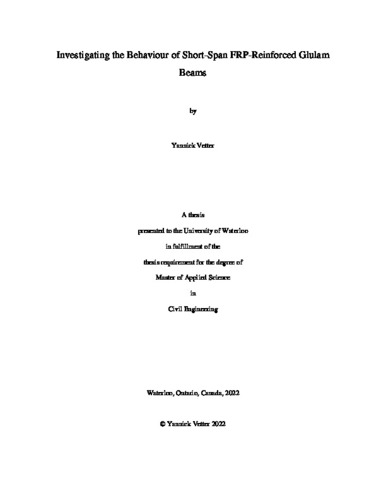| dc.contributor.author | Vetter, Yannick | |
| dc.date.accessioned | 2022-07-20 14:17:19 (GMT) | |
| dc.date.available | 2022-07-20 14:17:19 (GMT) | |
| dc.date.issued | 2022-07-20 | |
| dc.date.submitted | 2022-06-08 | |
| dc.identifier.uri | http://hdl.handle.net/10012/18457 | |
| dc.description.abstract | The broader availability of engineered wood products has generated a resurgence of wood used as a
construction material over the past few decades. To further promote the use of timber, a solution aimed
at increasing the structural capacity of aging or deficient members must be developed. The use of
externally bonded fibre reinforced polymer (FRP) sheets has been the subject of various studies that
have produced encouraging results.
This study was conducted to determine the effects of the reinforcement quantity and orientation on the
flexural response of short-span FRR-reinforced glulam beams. Special consideration was given to the
depth-to-span ratio and the effect of partially and fully confined reinforcement configurations on the
observed failure modes. A total of thirty glulam beams were tested under four-point loading with the
load at failure, midspan deflection, strain distribution and failure mode being recorded and used to
quantify the effect of the reinforcement. In addition to the experimental program, a non-linear model
was developed to predict the flexural resistance of unreinforced and reinforced beams. Individual
component testing was performed to determine the characteristic strengths of the materials needed as
input for the model.
Results for the simple tension and U-shaped reinforced glulam beams demonstrated increases in
resistance and stiffness compared to the control specimens; however, the combination of the span-to depth ratio and insufficient development length caused shear failures. The undesired failure mode was
addressed through the use of transversely applied FRP sheets. The addition of FRP hoops located in the
shear regions of the bending member helped increase the resistance by factors ranging up to 1.17 and
contained the failure to allow for some post-peak resistance. FRP sheets providing tension
reinforcement at the midspan and confinement in the shear spans were also investigated as means of
partially confined beams aimed at addressing the question of retrofitting members that have
accessibility issues and has shown to prevent undesirable failure modes while also providing some level
of post-peak resistance compared to conventional retrofitting schemes. Fully confined beams were also
the subject of this investigation to better understand the effect of the quantity of reinforcement and to
use a comparison to unconfined beams. The effect of beam depth was considered by replicating certain
reinforcement configurations on larger cross-sectional beams, with results demonstrating consistent
results. The material model used to generate the resistance curves was shown to generate a model to
experimental strength value ratio of 0.92. | en |
| dc.language.iso | en | en |
| dc.publisher | University of Waterloo | en |
| dc.title | Investigating the Behaviour of Short-Span FRP-Reinforced Glulam Beams | en |
| dc.type | Master Thesis | en |
| dc.pending | false | |
| uws-etd.degree.department | Civil and Environmental Engineering | en |
| uws-etd.degree.discipline | Civil Engineering | en |
| uws-etd.degree.grantor | University of Waterloo | en |
| uws-etd.degree | Master of Applied Science | en |
| uws-etd.embargo.terms | 0 | en |
| uws.contributor.advisor | Lacroix, Daniel | |
| uws.contributor.affiliation1 | Faculty of Engineering | en |
| uws.published.city | Waterloo | en |
| uws.published.country | Canada | en |
| uws.published.province | Ontario | en |
| uws.typeOfResource | Text | en |
| uws.peerReviewStatus | Unreviewed | en |
| uws.scholarLevel | Graduate | en |

